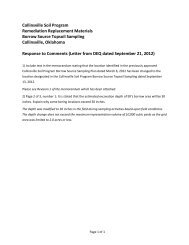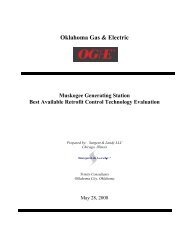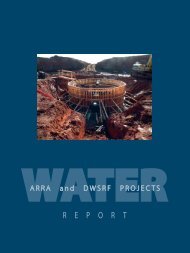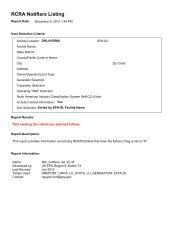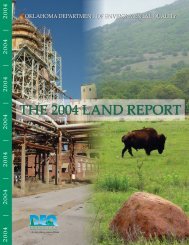Technical documentation and software quality assurance for project ...
Technical documentation and software quality assurance for project ...
Technical documentation and software quality assurance for project ...
You also want an ePaper? Increase the reach of your titles
YUMPU automatically turns print PDFs into web optimized ePapers that Google loves.
versus dosage <strong>for</strong> chemical inhalation. Also there was some discussion on setting ignition<br />
location. Center of cloud seemed to be conservative consensus.<br />
Flare notes<br />
View factor : There was discussion about using a cylindrical optically dense flame, as in<br />
the pool fire model rather than using point source view factor. One recommendation was<br />
to always assume a clear, dry day. This is equivalent to neglecting atmospheric<br />
dampening.<br />
gas exist velocity: Model currently assumes that flame will blow out when Mach number<br />
exceeds 0.5. Suggested that there may be a better number or that this restriction be<br />
dropped (flame could simply start farther away from source). Match rate of combustion<br />
to release rate to achieve steady state case. Most felt that horizontal jets also be allowed<br />
rather than only vertical ones. Model will not work well with oil fires due to smoke<br />
generation.<br />
2-phase: Model currently trans<strong>for</strong>ms 2-phase release into gas release. Some pointed out<br />
that 2-phase incident could produce both flare <strong>and</strong> pool fire. Suggested reviewing<br />
existing references on 2-phase flow to see how to h<strong>and</strong>le <strong>for</strong> flare situation<br />
BLEVE<br />
fireball size: Experts agreed that limits should be placed upon fireball size. One<br />
suggestion is to limit fireball mass to three times the fraction that is adiabatically flashed.<br />
Another is to restrict user input to largest common propane tank. Compare our simplified<br />
model to results from more sophisticated models.<br />
terminology: Consensus was that careful wordsmithing needs to be done to maintain<br />
consistency of language, technical accuracy, <strong>and</strong> fit within common usage.<br />
other hazards: Model only considers thermal hazard. People agreed that user should be<br />
warned about all hazards, including overpressure <strong>and</strong> shrapnel. Some discussion on<br />
shrapnel models<br />
Pool fire<br />
pool size: Model currently stops spreading when the burn rate equals the chemical release<br />
rate. Recommendation was to eliminate this restriction <strong>and</strong> stop spreading only when<br />
minimum thickness was reached. Need to ascertain upper limit on model applicability <strong>for</strong><br />
large fires.<br />
pool shape: Suggested that LOC footprint be circular rather than elliptical in order to be<br />
more conservative.<br />
burn regression rate: Approximation of burn regression rate as ratio of heat of<br />
combustion to heat of vaporization may not be good approximation, particularly <strong>for</strong><br />
43



